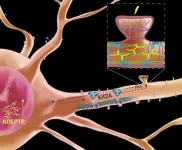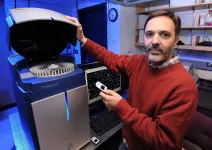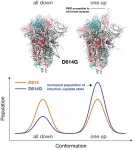INFORMATION:
In addition to Puthanveettil and Grinman, the authors of the study include Yosef Avchalumov, Isabel Espadas, and Supriya Swarnkar of Scripps Research, Florida; and Yoshihisa Nakahata and Ryohei Yasuda of the Max Planck Florida Institute for Neuroscience.
Neural plasticity depends on this long noncoding RNA's journey from nucleus to synapse
2021-04-16
(Press-News.org) JUPITER, FL--Making memories involves more than seeing friends or taking photos. The brain constantly adapts to new information and stores memories by building connections among neurons, called synapses. How neurons do this--reaching out arm-like dendrites to communicate with other neurons--requires a ballet of genes, signaling molecules, cellular scaffolding and protein-building machinery.
A new study from scientists at Scripps Research and the Max Planck Florida Institute for Neuroscience finds a central role for one signaling molecule, a long, noncoding RNA that the scientists named ADEPTR.
Using a variety of technologies, including confocal and two-photon microscopy, they track ADEPTR's moves, watching as it forms, travels, amasses at the synapse and activates other proteins upon a neuron's stimulation.
Its journey to the far reaches of a brain cell is made possible by a cellular carrier that that tiptoes along a dendrite's microtubule scaffolding. Called a kinesin motor, it deposits ADEPTR near the synapse junction, where it activates other proteins.
The team also found that if ADEPTR is silenced, new synapses don't form during stimulation.
The study, "Activity regulated synaptic targeting of lncRNA ADEPTR mediates structural plasticity by localizing Sptn1 and AnkB in dendrites," is published online April 16 in the journal Science Advances.
Long noncoding RNAs have often been described as "genomic dark matter," because their role in cells has yet to be fully characterized, especially in neurons, says the study's lead author, Scripps Research neuroscientist Sathyanarayanan Puthanveettil, PhD. Puthanveettil's team is finding that they play a signaling role in neural plasticity--how neurons adapt and change with experience.
"Here we report activity-dependent dendritic targeting of a newly transcribed long noncoding RNA for modulating synapse function, and describe its underlying mechanisms," Puthanveettil says. "These studies bring novel insights into the functions of long noncoding RNAs at the synapse."
The first author is Eddie Grinman, a graduate student in Puthanveettil's lab.
A long noncoding RNA is a type of RNA that exceeds 200 nucleotides, and does not get translated into protein. There are thousands of these long noncoding RNA in our cells, but in most cases, their function isn't yet known. What is known is that usually, they tend to stay within the cell nucleus. Some regulate the transcription of genes.
"It was surprising to see a long noncoding RNA move from nucleus to the synapse so rapidly and robustly," Grinman says.
The hippocampus is the part of the brain where learning, memory and emotions reside. Working in hippocampal neurons from mice, the team stimulated the neurons with pharmacological activators of learning-related signaling. They found through molecular and high-resolution imaging techniques that the ADEPTR long noncoding RNA was rapidly expressed and transported to the outer arms of the cell. There, the ADEPTR molecules interact with proteins that play a role in structural organization of synapses, proteins called spectrin 1 and ankyrin B.
They found that ADEPTR became downregulated if exposed to an inhibitory neurotransmitter, GABA.
"These findings add another layer of complexity in synapse modulation and plasticity," Puthanveettil says. "Synaptically localized long noncoding RNA are important regulators of adaptive neuronal function."
Going forward, the team intends to continue characterizing how stimulation affects neuronal plasticity. Also, the authors hope to learn more about the role of ADEPTR in vivo.
"It would be interesting to learn what role ADEPTR plays in forming new memories in living organisms," says Grinman.
The work is revealing one of the most fundamental processes of learning and memory, adaptation to changing information and circumstances.
"Neural plasticity is what allows us to learn, respond to stimuli, and lay down long-term memories," Puthanveettil says. "There is still much to learn about the magnificent complexity of this fundamental biological process."
ELSE PRESS RELEASES FROM THIS DATE:
A new guide for communicating plant science
2021-04-16
AMES, Iowa - A lot is riding on the continued advancement of plant sciences.
Take the food supply, for starters. Climate change and population growth will continue to pose challenges in the future, and crop production will require innovation and progress by plant scientists in order to keep pace. It isn't an overstatement to say that populations around the world will go hungry if plant science stagnates, said Gustavo MacIntosh, a professor in the Roy J. Carver Department of Biochemistry, Biophysics and Molecular Biology at Iowa State University.
"At the end of the day, either you eat plants or you eat food that ate plants," MacIntosh said. "Plants are the basis for the food we have."
MacIntosh predicts ...
The future of particle accelerators is here
2021-04-16
When the Electron Ion Collider received the go-ahead in January 2020, it became the only new major accelerator in the works anywhere in the world.
"All the stars aligned," said Elke-Caroline Aschenauer, Brookhaven National Laboratory Staff Scientist and a leader in developing the EIC plans. "We have the technology to build this unique particle accelerator and detector to do the measurements that, together with the underlying theory, can for the first time provide answers to longstanding fundamental questions in nuclear physics."
The EIC isn't the only Brookhaven project poised to reshape nuclear and particle physics. Forthcoming data from the Relativistic Heavy Ion Collider could finally detect the elusive chiral magnetic effect. Meanwhile, planned accelerators could run on sustainable ...
Simulations reveal how dominant SARS-CoV-2 strain binds to host, succumbs to antibodies
2021-04-16
LOS ALAMOS, N.M., April 16, 2021 -- Large-scale supercomputer simulations at the atomic level show that the dominant G form variant of the COVID-19-causing virus is more infectious partly because of its greater ability to readily bind to its target host receptor in the body, compared to other variants. These research results from a Los Alamos National Laboratory-led team illuminate the mechanism of both infection by the G form and antibody resistance against it, which could help in future vaccine development.
"We found that the interactions among the basic building blocks of the Spike protein become ...
New understanding of the deleterious immune response in rheumatoid arthritis
2021-04-16
Researchers within the Biomedicine Discovery Institute at Monash University have made a breakthrough in understanding the role played by high-risk immune genes associated with the development of rheumatoid arthritis (RA).
The findings, published in Science Immunology, were the result of a seven-year collaboration led by Monash University, involving Janssen Research and Development, USA and the Karolinska Institute, Sweden.
Certain immune system genes, called Human Leukocyte antigen (HLA)-DR4, cause an increased susceptibility to RA. In this study, using mice genetically ...
The Trojan-Horse mechanism: How networks reduce gender segregation
2021-04-16
The social science literature has long viewed homophily and network-based job recruitment as crucial drivers of segregation. Researchers at Linköping University and ESADE, Ramon Llull University now show that this view must be revised. In their Science Advances article, they call attention to a previously unidentified factor, the Trojan-horse mechanism, which shows that network-based recruitment can reduce rather than increase segregation levels.
The segregation of labor markets along ethnic and gender lines is an important source of socio-economic inequalities. Therefore, the understanding the mechanisms that drive segregation ...
Science Advances publishes proteomics technology from Oblique Therapeutics AB
2021-04-16
Science Advances publishes proteomics technology from Oblique Therapeutics AB with a potential to bring several novel antibody medicines to large patient populations in multiple disease areas
Gothenburg, Sweden, April 16th, 2021 - Oblique Therapeutics AB, a Sweden-based biotech company, in collaboration with Karolinska Institutet (Stockholm, Sweden), Gothenburg University (Sweden) and several local biotechs published promising research results in the highly-acclaimed scientific journal Science Advances (AAAS) entitled: Rational Antibody design for Undruggable Targets using Kinetically Controlled Biomolecular ...
Female protective effect: Yale researchers find clues to sex differences in autism
2021-04-16
New Haven, Conn. -- It is well established that autism occurs much more frequently in boys than in girls, and that girls seem to have a greater resilience to developing the condition. It has been unclear, however, why that is.
In a new Yale-led study, researchers find that autism may develop in different regions of the brain in girls than boys and that girls with autism have a larger number of genetic mutations than boys, suggesting that they require a larger "genetic hit" to develop the disorder.
The findings appear in the April 16 edition of the journal ...
Researchers revise indicator of mobility limitation in older adults
2021-04-16
Aging entails a loss of muscle mass and strength, which in some cases impairs mobility, hinders walking or performance of day-to-day tasks, and exposes the elderly to the risk of falls and hospitalizations.
In clinical practice, handgrip measurement is the most widely used method to identify loss of overall muscular strength in older people. Values below 26 kg for men and 16 kg for women have for some time been considered an indication of risk-associated weakness, but these parameters are being revised.
Researchers at the Federal University of São Carlos (UFSCar) in the state of São Paulo, Brazil, collaborating with colleagues at other institutions in the same state such as the University of São Paulo's Ribeirão Preto Medical School (FMRP-USP), Nursing School ...
Study shows past COVID-19 infection doesn't fully protect young people against reinfection
2021-04-16
Although antibodies induced by SARS-CoV-2 infection are largely protective, they do not completely protect against reinfection in young people, as evidenced through a longitudinal, prospective study of more than 3,000 young, healthy members of the US Marines Corps conducted by researchers at the Icahn School of Medicine at Mount Sinai and the Naval Medical Research Center, published April 15 in The Lancet Respiratory Medicine.
"Our findings indicate that reinfection by SARS-CoV-2 in health young adults is common" says Stuart Sealfon, MD, the Sara B. and Seth M. Glickenhaus Professor of Neurology at the Icahn School of Medicine at Mount Sinai and senior author of the paper. "Despite a prior COVID-19 infection, young people can catch the virus ...
A new super-Earth detected orbiting a red dwarf star
2021-04-16
In recent years there has been an exhaustive study of red dwarf stars to find exoplanets in orbit around them. These stars have effective surface temperatures between 2400 and 3700 K (over 2000 degrees cooler than the Sun), and masses between 0.08 and 0.45 solar masses. In this context, a team of researchers led by Borja Toledo Padrón, a Severo Ochoa-La Caixa doctoral student at the Instituto de Astrofísica de Canarias (IAC), specializing in the search for planets around this type of stars, has discovered a super-Earth orbiting the star GJ 740, a red dwarf star situated some 36 light years from the Earth.
The planet orbits its star with a period of 2.4 days and its mass is around 3 ...







